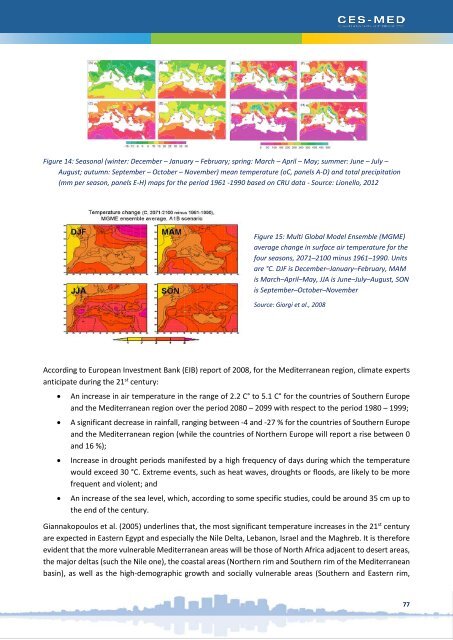130218_Luxor-Egypt SECAP Final
Create successful ePaper yourself
Turn your PDF publications into a flip-book with our unique Google optimized e-Paper software.
Figure 14: Seasonal (winter: December – January – February; spring: March – April – May; summer: June – July –<br />
August; autumn: September – October – November) mean temperature (oC, panels A-D) and total precipitation<br />
(mm per season, panels E-H) maps for the period 1961 -1990 based on CRU data - Source: Lionello, 2012<br />
Figure 15: Multi Global Model Ensemble (MGME)<br />
average change in surface air temperature for the<br />
four seasons, 2071–2100 minus 1961–1990. Units<br />
are °C. DJF is December–January–February, MAM<br />
is March–April–May, JJA is June–July–August, SON<br />
is September–October–November<br />
Source: Giorgi et al., 2008<br />
According to European Investment Bank (EIB) report of 2008, for the Mediterranean region, climate experts<br />
anticipate during the 21 st century:<br />
• An increase in air temperature in the range of 2.2 C° to 5.1 C° for the countries of Southern Europe<br />
and the Mediterranean region over the period 2080 – 2099 with respect to the period 1980 – 1999;<br />
• A significant decrease in rainfall, ranging between -4 and -27 % for the countries of Southern Europe<br />
and the Mediterranean region (while the countries of Northern Europe will report a rise between 0<br />
and 16 %);<br />
• Increase in drought periods manifested by a high frequency of days during which the temperature<br />
would exceed 30 °C. Extreme events, such as heat waves, droughts or floods, are likely to be more<br />
frequent and violent; and<br />
• An increase of the sea level, which, according to some specific studies, could be around 35 cm up to<br />
the end of the century.<br />
Giannakopoulos et al. (2005) underlines that, the most significant temperature increases in the 21 st century<br />
are expected in Eastern <strong>Egypt</strong> and especially the Nile Delta, Lebanon, Israel and the Maghreb. It is therefore<br />
evident that the more vulnerable Mediterranean areas will be those of North Africa adjacent to desert areas,<br />
the major deltas (such the Nile one), the coastal areas (Northern rim and Southern rim of the Mediterranean<br />
basin), as well as the high-demographic growth and socially vulnerable areas (Southern and Eastern rim,<br />
77

















